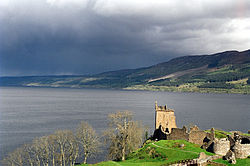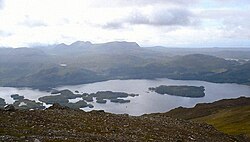Largest water bodies in the United Kingdom




This table includes the ten largest fresh water bodies by area. Lough Neagh is the largest water body in the UK by this measure, although Loch Ness is the largest by volume and contains nearly double the amount of water in all the lakes of England and Wales combined. [1] Loch Morar is the deepest of the UK's lakes and Loch Awe the longest. Murray and Pullar (1910) note that the mean depth of Loch Ness is 57.4% of the maximum depth – higher than in any other large deep loch in Scotland. [2] The deepest lake in England is Wast Water which descends to 76 metres (249 ft).
| Rank | Name | Location | Area (mi2) | Area (km2) | Volume (km3) | Length (km) | Max. depth (m) | Mean depth (m) [3] |
|---|---|---|---|---|---|---|---|---|
| 1 | Lough Neagh | Northern Ireland | 147.87 | 383 [4] | 3.528 | 30 | 25 | 9 |
| 2 | Lower Lough Erne | Northern Ireland | 42.28 | 109.5 [5] | 1.3 [6] | 29 [7] | 62 [6] | 11.9 [5] |
| 3 | Loch Lomond | Scotland | 27.45 | 71 | 2.6 | 36 | 190 | 37 [8] |
| 4 | Loch Ness | Scotland | 21.78 | 56 | 7.45 | 39 | 230 | 132 [2] |
| 5 | Loch Awe | Scotland | 14.85 | 39 | 1.2 | 41 | 94 | 32 [9] |
| 6 | Upper Lough Erne | Northern Ireland | 13.3 | 34.5 [5] | < 0.35 | 19 [7] | < 60 [7] | 2.3 [5] |
| 7 | Loch Maree | Scotland | 11.03 | 28.6 | 1.09 | 20 | 114 | 38 [10] |
| 8 | Loch Morar | Scotland | 10.3 | 27 | 2.3 | 18.8 | 310 | 87 [11] |
| 9 | Loch Tay | Scotland | 10.19 | 26.4 | 1.6 | 23 | 150 | 60.6 [12] |
| 10 | Loch Shin | Scotland | 8.7 | 22.5 | 0.35 | 27.8 | 49 | 15.5 [13] |